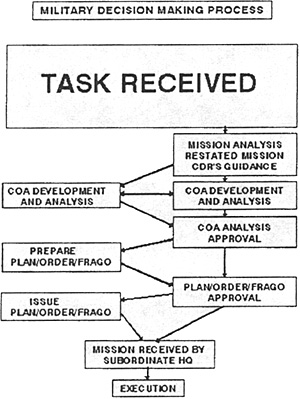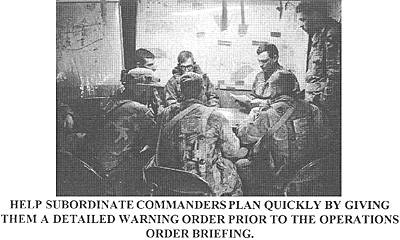 "Your staff won't win the war for you, but it can prevent you from winning."
"Your staff won't win the war for you, but it can prevent you from winning."
- --BG John E. Miller
OBSERVATION:
Commanders and staffs must optimize available time by providing subordinates information to begin planning and preparing for the mission.
DISCUSSION:
During the MDMP the commander and staff receive and develop information that is useful to subordinates. To aid subordinates in planning, the commander and staff provide information as frequently as possible, maximizing the subordinate's planning and preparation time.
The commander and staff send warning orders at key times during the MDMP to provide subordinates planning information.
Send the first warning order once the mission is received from the higher unit.
Provide subordinates the type, time and location of operation. This allows subordinates to begin planning and managing available time, prepare necessary equipment, and begin conducting rehearsals and battle drills.
Send the second warning order after the commander and staff have analyzed the mission.
Provide as much new information as possible (restated mission and tasks); include any specific instructions that subordinates need to aid them in organizing their planning and preparation time.
Send the third warning order after the commander has decided the course of action and has developed a concept of operation.
With a course of action selected, tell subordinates the task organization and their specified tasks. By providing the task organization, units can begin cross-attaching and coordinating changes in support. Provide subordinates copies of draft operational graphics and a brief explanation of the concept of operation if time is available. This allows them to begin parallel planning, while the battalion or brigade operations order is developed.
Parallel planning is a technique similar to multiple warning orders. Parallel planning allows subordinate commanders and staffs to plan and prepare while the higher staff produces their plan. This would prevent planning sequentially, with the subordinate commander receiving the higher commander's order before beginnning to plan. By parallel planning, subordinate units have more available time because they receive information earlier than they would during sequential planning. During parallel planning, the higher commander provides subordinate commanders his concept of the operation and details of the plan as soon as they are developed. This is done best by the commander meeting and quickly briefing his subordinates.
 HELP SUBORDINATE COMMANDERS PLAN QUICKLY BY GIVING THEM A DETAILED WARNING ORDER PRIOR TO THE OPERATIONS ORDER BRIEFING.
HELP SUBORDINATE COMMANDERS PLAN QUICKLY BY GIVING THEM A DETAILED WARNING ORDER PRIOR TO THE OPERATIONS ORDER BRIEFING.
Parallel planning conserves time for all echelons, but demands close coordination between commanders and staffs. Even after the commander has met with subordinate commanders, the brigade and battalion must maintain close contact during planning. If not, the brigade may change the concept, and the battalion will produce an erroneous order.
LESSONS:
- Commander and staff: Send multiple warning orders to maximize subordinate planning and preparation time.
- Commander and staff: Conduct parallel planning by providing subordinate commanders the concept of the operation and specified tasks when they are developed.
Back to Table of Contents -- Battalion and Brigade Battle Staff
Back to CALL List of Issues
Back to MagWeb Magazine List
© Copyright 2004 by Coalition Web. Inc.
This article appears in MagWeb.com (Magazine Web) on the Internet World Wide Web.
Other articles from military history and related magazines are available at http://www.magweb.com